
|
Omaggio
a Roberto Borsa (1880-1965) Cuggiono
e il suo territorio nei dipinti di un neo impressionista lombardo Esposizione
di opere presso lo spazio polifunzionale "Le radici e le
ali" , S. Maria in Braida - Cuggiono 22
Dicembre 2007 - 3 Febbraio 2008 Testi
di Donatella Tronelli, traduzione inglese di Ernesto Milani Cliccare
sull'immagine per ingrandirla |
Tribute
to Roberto Borsa (1880-1965)
Cuggiono
and its territory by a lombard
neo-impressionist
Paint
exhibition in "Le radici e le ali", S. Maria in Braida -
Cuggiono
December,
22 - February,3 2008
Text
by Donatella Tronelli, english translation by Ernesto Milani
Click
on the image to enlarge
|
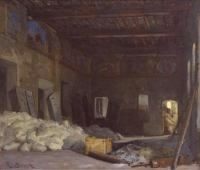
|
1.
Interno di Villa Clerici a
Castelletto di Cuggiono
Olio
su tavola, 40 × 50
cm
Firmato
in basso a sinistra, non datato
Sul
retro la riflessione, di pugno dell’artista: Sic transit gloria mundi
Collezione
privata
In
mostra si propone anche un disegno della stessa Villa, ripresa dal
ponte di Castelletto di Cuggiono.
Costruita
alla metà del ’600,
Villa Clerici è uno degli edifici caratteristici sul Naviglio
Grande, detti comunemente “castelletti”. Dopo l’estinzione
dei Marchesi Clerici, che nella seconda metà del ’600
erano stati feudatari di Cuggiono, la Villa subì vari destini,
trasformata anche in sede industriale, con la conseguenza di un
inarrestabile degrado, del quale è testimone questo dipinto, che
ne ritrae un interno, un tempo fastoso, con il commento, appunto, Sic
transit gloria mundi. E sì che nel 1743
l’incisore Marc’Antonio Dal Re, nel suo Ville
di delizia, descriveva Villa Clerici come “tra le più
imponenti di Lombardia” da cui si scorgevano “a Tramontana il
Sacro Monte di Varese, a Mezzogiorno la città di Vigevano, ed a
Sera, quella di Novara”.
|
1.Castelletto
di Cuggiono : Interior of Villa Clerici
Oil
on wood , 40 X 50 cm.
Signed
on the lower left side, undated.
On
the back , a thought handwritten by the artist : Sic
transit Gloria mundi (thus passes the glory of the world).
The
exhibit also displays a drawing of the same Villa with a view
taken from the bridge of Castelletto di Cuggiono. Villa Clerici,
built around the mid -1600s, is one of the picturesque buildings
along the Naviglio Grande, commonly referred to as
“castelletti” (chatelet). After the extintion of the Marchesi
Clerici, who had been large landowners in Cuggiono in the second
half of the 1600s, the Villa was used in different ways and even
transformed into an industrial site with a consequent unstoppable
degradation witnessed by this painting where the interior once
magnificent is now commented with : Sic
transit Gloria mundi. In 1743 the engraver Marc’Antonio Dal
Re, in his Ville di delizia
(Villas of enchantment) described Villa Clerici as “one
of the greatest in Lombardy” from where one could see the Sacro
Monte of Varese (The Holy Mountain of Varese) to the North, the
city of Vigevano to the South and Novara to the West.
|
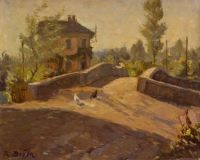 |
2.
Il ponte di Castelletto di
Cuggiono
Olio
su tavola, 40 × 50
cm
Firmato
in basso a destra, non datato
Collezione
privata
Immagine
simbolo del territorio, il ponte fu più volte ripreso anche da
Borsa, nelle differenti angolazioni. Come esempi, qui se ne
propongono due versioni, questa e il n. 34,
che parrebbe posteriore per la tavolozza decisamente schiarita e
l’atmosfera più soffusa e meno naturalista.
|
2.
Castelletto
di Cuggiono : The bridge
Oil
on wood , 40 X 50 cm.
Signed
on the lower right side, undated.
Private
collection.
The
bridge, a symbol image of the territory, was painted many times by
Borsa from different angles. For example, we have on display two
versions, this one and n. 34 which seems a posterior work on
account of his lighter palette, a softer and less naturalist
atmosphere.
|
|
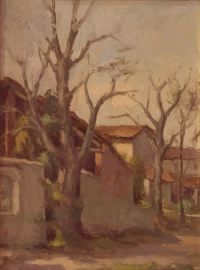
|
3.
Via Magenta, Cuggiono
Olio
su masonite, 50 × 40
cm
Firmato
in basso a sinistra, non datato
Collezione
privata
Il
dipinto apre, nella mostra, la serie delle vedute urbane di
Cuggiono.
Dovrebbe
trattarsi dell’angolo fra le vie Magenta e Cristoforo Colombo.
|
3.
Cuggiono
: via Magenta
Oil
on masonite , 50 X40 cm.
Signed
on the lower left side, undated.
Private
collection.
This
painting is the first of a series of Cuggiono urban views at the
exhibit.
It
is likely the corner between via Magenta and Cristoforo Colombo.
|
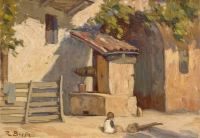
|
4.
Cortile in via Pellegatta,
Cuggiono
Olio
su tela, 35 × 50
cm
Firmato
in basso a sinistra, non datato
Comune
di Cuggiono
Il cortile, detto anche
“della Madonna” per la presenza di un dipinto murale, pare
fosse particolarmente ‘vivace’, almeno secondo la
testimonianza dell’allora bambino con carriola, ritratto nel
quadro, oggi noto professionista cittadino. In primo piano la casa
dove vivevano la cartomante Maria Majno e Paolo Sereni, originale
e conosciuta figura di ex marinaio, che per vivere pescava e
vendeva pesce.
|
4.Cuggiono
: Courtyard in via Pellegatta
Oil
on canvas, 35 X 50 cm.
Signed
on the lower left side, undated
Commune
of Cuggiono
The
courtyard, also known as that of “the Madonna” due to a mural
painting, was quite lively according to the boy with the wheel
barrow portrayed in the painting, who is now an important
professional in Cuggiono.
On
the foreground the house inhabited by the fortune-teller Maria
Maino and Paolo Sereni, an original and well-known former sailor
who made a living by
fishing and selling fish.
|
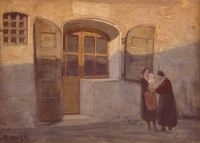 |
5.
Vecchio forno
Olio
su tela, 30 × 40
cm
Firmato
in basso a sinistra, non datato
Comune
di Cuggiono
Noto come “Forno del Cirlìn”.
Siamo all’inizio di via Beolchi a Cuggiono.
|
5.
Old
Oven
Oil
on canvas , 30 X 50 cm.
Signed
on the lower left side, undated
Commune
of Cuggiono.
Known
as “Cirlìn’s Forno” .
It’s at the entrance of via Beolchi in Cuggiono.
|
|
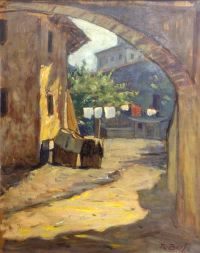
|
6.
Villa Annoni da un cortile
di via Beolchi, Cuggiono
Olio
su tavola, 50 × 40
cm
Firmato
in basso a destra, non datato
Comune
di Cuggiono
Il cortile in questione è tuttora
riconoscibile, oltre i cambiamenti intervenuti nell’arco degli
anni.
Stranamente, se vogliamo, si è
rintracciato solo questo dipinto in cui compaia – seppur in
scorcio all’orizzonte – la sontuosa Villa Annoni, che pure è,
con il suo splendido parco, il vanto di Cuggiono; commissionata
– secondo la tesi più diffusa – sul finire del Settecento
all’architetto genovese Giuseppe Zanoja. Non è certo escluso
che vi siano altre opere, non rinvenute al momento, con la Villa,
ma certo essa non fu soggetto privilegiato dell’artista.
Forse perché le origini di Borsa
pittore s’innestano nella tradizione del verismo lombardo,
ammantato di valenze sociali, della seconda metà dell’Ottocento
e, dunque, nelle vedute si privilegia il tessuto ‘del borgo’,
quello della quotidianità vissuta, con la costante presenza delle
figure e, magari, i panni stesi al sole.
Stesso discorso potrebbe riferirsi
anche all’Interno di Villa
Clerici (n. 1), còlta non nella magnificenza della struttura
ma nella realtà effettiva del momento.
|
6.
Cuggiono : Villa Annoni from a courtyard in via Beolchi.
Oil
on wood, 50 X40 cm.
Signed
on the lower right side, undated.
Commune
of Cuggiono.
The
courtyard is still recognizable in spite of the changes that have
occurred through the years.
Strangely
this is the only painting found depicting – albeit a view on the
horizon – the sumptuous villa Annoni that with its splendid park
is the pride of Cuggiono ; commissioned, most probably, at the end
of the eighteenth century to the Genoese architect Giuseppe Zanoja.
There might be other works on the Villa, still undiscovered,
although it wasn’t a favourite subject of the artist, maybe
because Borsa’s style is grafted into the tradition of Lombard
verism of the second half of the nineteenth century, full
of social values and thus the view favors the “borgo”
fabric
(village
fabric) with its daily life with the constant presence of people
and maybe the clothes drying in the sun.
The
same applies to the Interior
of Villa Clerici (n1.) captured in the effective reality of the moment
rather than in the grandiosity of the structure.
|
|
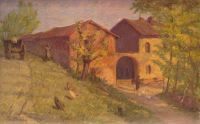
|
7.
Cascina del Sciuc
Olio
su tela, 51 × 80
cm
Firmato
in basso a sinistra, non datato
Collezione
privata
Del dipinto, esistono anche, in
collezione privata, uno studio preparatorio (olio su cartone
pressato, 15,5 × 22 cm, titolato sul retro Cascina
del Sciuc) e un disegno (matita su carta, 240 × 360 mm,
titolato e datato in basso a sinistra Cascina
del Sciuc 1938 Pasqua).
La
Cascina – oggi ristrutturata – si
trova nelle immediate vicinanze dell’alzaia del Naviglio, sul
lato opposto rispetto alla più conosciuta Cascina Confetteria,
anch’essa ripresa in altra opera dall’artista (olio su tavola,
23 × 24 cm; collezione privata).
|
7.
Sciuc’s
farmhouse
Oil
on canvas, 51 X 80 cm.
Signed
on the lower left side, undated
Private
collection.
A
private collection has a preparatory study (oil on pressed
cardboard, 15.5 X 22 cm., titled on the back Cascina
del Sciuc) and a drawing ( pencil on paper, 240 X360 mm.,
titled and dated on the lower left side Cascina
del Sciuc 1938 Easter).
The
farmhouse – now restructured – is located near the embankment
of the Naviglio, on the opposite side of the better known Cascina
Confetteria, also portrayed in another work by the artist (oil on
wood, 23 X 24 cm., private collection).
|
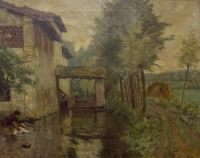 |
8.
Il mulinetto, 1944
Olio
su tela, 80 × 100
cm
Firmato
in basso a sinistra
Datato
dall’artista in un album fotografico appartenente all’Archivio
Borsa
Milano,
Collezione Borsa
Il “mulinetto” – come
comunemente è chiamato – si
trova lungo una roggia non distante dal ponte di Castelletto sulla
via per il Ticino. Oggi, purtroppo, un’alta siepe lo cela alla
vista dalla strada.
|
8.
The
small water-mill.1944
Oil
on canvas, 80 X100 cm.
Signed
on the lower left side
Dated
by the artist in a photographic scrapbook
of Milan, Borsa Archivi, Borsa Collection.
The
“mulinetto” – its common name – is located along a
millstream close to the bridge of Castelletto on the way to the
Ticino river. Nowadays a tall hedge
conceals
its view from the road.
|
|
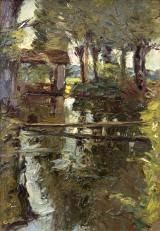
|
9.
Il mulinetto, 1922
ca
Olio
su tavola, 22 × 15
cm
Firmato
in basso a destra, non datato
Collezione
privata
Sempre
in un album fotografico d’archivio, si trova la riproduzione di
un dipinto molto vicino a questo, per misure, stile e inquadratura
(oggi non rintracciato), con data, di pugno dell’artista, “1922”.
La
differenza di vent’anni fra quest’opera e la precedente
ribadisce come Borsa amasse tornare nel tempo su soggetti
particolarmente cari (lo si è già ricordato per il ponte di
Castelletto di Cuggiono).
Il
parallelo fra i due lavori, a parte il divario di dimensioni, è
testimonianza diretta dell’evolversi stilistico del pittore da
un cromatismo vivace e pastoso a toni più spenti e a una materia
più povera e sfumata.
|
9.
The
small water-mill, circa 1922
Oil
on wood, 22 X15 cm.
Signed
on the lower right side, undated
Private
collection.
The
reproduction of a painting similar to this one in dimensions,
style and framing (not yet found) duly signed by the artist
“1922”, may be seen in an archival photographic scrapbook.
The
difference of twenty years between this work and the previous one
confirms how Borsa loved to return in time on beloved subjects (
see also the bridge of Castelletto di Cuggiono).
The
comparison between the two works, besides the difference in
dimensions, witnesses the technical evolution of the painter from
a bright and mellow chromatism to dull tones and a poorer and
shaded matter.
|
|
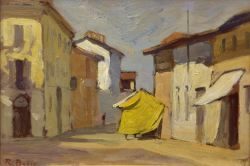
|
10.
Banchetto della “Nina”
in via san Rocco, Cuggiono
Olio
su tavola, 18 × 27
cm
Firmato
in basso a sinistra, non datato
Collezione
privata
Noto
personaggio Cuggionese, la “Nina” vendeva dolciumi e
‘sfizi’ vari, dalle caramelle alla liquirizia. In primo piano,
sulla destra, l’ingresso della bottega di “Nora”, altra
protagonista della vita di questo angolo di paese, tuttora
preziosa fonte di memorie.
Va detto che via San Rocco
costituiva il centro motore della vita commerciale di Cuggiono
(oggi, è quasi immutata sul lato sinistro da piazza San Giorgio,
mentre è completamente cambiato il fianco destro).
Colpisce
l’estrema modernità, d’atmosfera metafisica, della
composizione, con la libertà prospettica e la sintesi delle
geometrie che avvicinano il piccolo dipinto a una scenografia
teatrale.
|
10.
Cuggiono
. Nina’s stand in via san Rocco
Oil
on wood, 18 X27 cm.
Signed
on the lower left side, undated
Private
collection
“Nina”
was a well-known Cuggionese character who sold sweets and various
delicacies, from candies to licorice. On the foreground, on the
right, the entrance to Nora’s shop, another protagonist of this
corner of the village, still a precious source of memories.
Via
san Rocco represented the center of commercial activities in
Cuggiono (now it’s almost the same on the left side from piazza
san Giorgio, while the right side has completely changed).
The
extreme modernity and metaphysical atmosphere of the composition
are impressive : its prospective freedom and the geometric
synthesis make the small painting similar to a theatrical
scenography. |
|
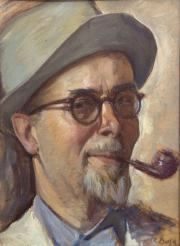
|
11.
Autoritratto, anni
Cinquanta
Olio
su tavola, 40 × 30
cm
Firmato
in basso a destra, non datato
Milano,
Collezione Borsa
Per le caratteristiche somatiche
databile agli anni Cinquanta, quando Borsa, nato nel 1880, aveva
sui settant’anni e ancora molta autoironia, espressa con la
capacità introspettiva di sapiente ritrattista (fra gli altri,
cinque ritratti da lui eseguiti figurano nella Quadreria
dell’Ospedale Maggiore di Milano, che raccoglie, lungo cinque
secoli, le immagini dei benefattori, realizzate dagli artisti
prescelti su specifico incarico del Consiglio ospedaliero). Con l’autoritratto si apre,
nella mostra, una piccola
sezione biografica, legata
in particolare all’ambito cuggionese.
|
11.
Self-portrait, 1950s
Oli
on wood, 40 X30 cm.
Signed
on the lower right side, undated
Milan,
Borsa Collection
His
features make it datable around the 1950s when Borsa, who was born
in 1880, was in his seventies and still capable of self-mockery
that he expressed with the introspect ability of a skillful
portrait-painter (five
of his portraits are displayed in the Painting Gallery of the
Ospedale ( Hospital) Maggiore of Milan that collects the images of
benefactors throughout five centuries made by artists specifically
selected by the Hospital council).
This
self-portrait starts the exhibit’s biographical section
particularly linked to the Cuggiono area. |
|
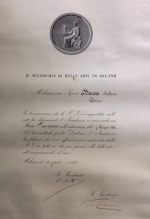
|
12.
Attestato di nomina a Socio
Onorario dell’Accademia di Brera
“per
la benemerenza acquistata nelle arti”, in data 14
agosto 1912,
firmato da Camillo Boito, Presidente dell’Accademia e Preside
della Facoltà di Architettura, anch’essa all’epoca con sede
in Brera.
Nel
1912 Borsa ha
trentadue anni. A Brera era entrato, come allievo, a diciotto,
studiando sotto la guida di Giuseppe Mentessi e Cesare Tallone.
Milano,
Archivio Borsa
|
12.
Certificate of appointment as honorary member of Brera Academy
“for
merit acquired through arts”, dated 14 August 1912, signed by
Camillo Boito, President of the Academy and Dean of the Faculty of
Architecture, then still located at Brera. In 1912 Borsa was 32.
He had entered Brera as a student at 18 under the guidance of
Giuseppe Mentessi and Cesare Tallone.
Milan,
Archivio Brera
|
|
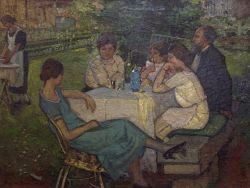
|
13.
Ore serene, 1924
Olio
su tela, 70 × 100
cm
Firmato
e datato in basso a sinistra, titolato a retro, sul telaio
Milano,
Collezione Borsa
Il
dipinto risulta esposto alla mostra “L’arte e il Convito”
alla Permanente di Milano nel 1957
(sala 13, n. 243).
Ritratto
di famiglia in un esterno: la moglie cuggionese dell’artista,
Maria Clerico (in primo piano), il padre, la madre, la sorella, il
primogenito Gianfranco di tre anni. E, simbolo di buona borghesia,
la cameriera abbigliata ‘comme
il faut’.
Il
giardino, in fondo a via San Rocco, Cuggiono, apparteneva alla famiglia
Clerico. Oggi è occupato da edifici; ne è rimasta solo una
parte, se pure completamente modificata, adibita a uso pubblico
|
13.
Quiet
hours, 1924
Oil
on canvas, 70 X100 cm.
Signed
and dated on the lower left side, titled on the back, on the frame.
Milan,
Borsa Collection
The
painting was displayed at the exhibit “L’arte e il Convito”
at the Permanente of Milan in 1957 ( room 13, n. 243).
Portrait
of a family outdoors : the artist’s Cuggionese wife, Maria
Clerico (in the foreground), the father, the mother, the sister,
the first-born Gianfranco, then three-years old. And as a symbol
of middle class, the maid dressed “as
it should be” .
The
garden, at the end of via San Rocco, Cuggiono, belonged to the
Clerico family. Today it is occupied by buildings ; the only part
left, even if completely modified, has been destined to public use.
|
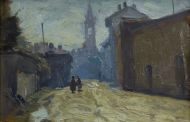
|
14.
Via San Rocco, Cuggiono
Olio
su tavola, 14 × 19
cm
Firmato
in basso a sinistra, non datato
Collezione
privata
Oltre
il muro in fondo a sinistra si apre il giardino della famiglia
Clerico.
|
14.
Cuggiono
: via San Rocco
Oil
on wood, 14 X19 cm.
Signed
on the lower left side, undated.
Private
collection.
On
the far left on the wall, view of the Clerico’s family garden
opens up.
|
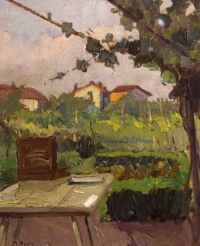
|
15.
In giardino, 1932
Olio
su tavola, 40 × 36
cm
Firmato
in basso a sinistra
Titolato
e datato sul retro “Cuggiono 1932/
In giardino”
Milano,
Collezione Borsa
Ancora
l’interno dello stesso giardino in prospettiva più sfondata.
L’immagine è allusiva. Come se l’artista, che probabilmente
sta dipingendo, fosse presente nella sua cassetta dei colori
aperta.
|
15.
In the garden, 1932
Oil
on wood, 40 X36 cm.
Signed
on the lower left side
Titled
and dated on the back : “Cuggiono 1932/ in the garden”.
Milan,
Borsa Collection
The
interior of the same garden with a long perspective. The image is
allusive. The artist, who is probably painting, seems to be
present in his open colour-box.
|
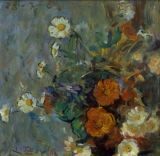
|
16.
Fiori, 1963
Olio
su tavola, 35 × 35
cm
Firmato
in basso a sinistra
Datato
in alto a sinistra, con il pennello, 28.7.63
Collezione
privata
Si
è inteso dare un esempio, particolarmente felice, di un’altra
tematica tipica di Borsa (oltre all’attività di ritrattista e
incisore). È qui più evidente che altrove la tecnica del contour,
che con il tratto sottile e nero di pennello contorna e disegna le
figure, definendole e staccandole dal fondo. Un lavoro sulla forma
in cui s’imponga la linea.
|
16.
Flowers, 1963
Oil
on wood, 35 x35 cm.
Signed
on the lower left side
Dated
by brush on the left top side, 28 July 1963
Private
collection.
This
is an example of the typical themes of Borsa, besides his activity
as a portrait –painter and engraver. The contour
technique is quite highlighted by the thin and black brush
stroke that outlines and draws the figures, defining them and
detaching them from the bottom. A study on the form in which the
line emerges.
|
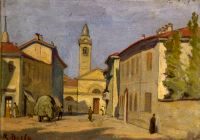
|
17.
Chiesa Vecchia da piazza
San Giorgio, Cuggiono
Olio
su cartone pressato, 15,5
× 22 cm
Firmato
in basso a sinistra, non datato
Collezione
privata
La
vecchia parrocchiale di San Giorgio – dal 1846
di Santa Maria delle Grazie – oggi non esiste più, ma già
aveva perso la propria funzione, nel 1633,
con l’apertura al culto della “chiesa nuova” di San
Giorgio.
Anche se probabilmente di origini
precedenti (lo proverebbe l’altare rigorosamente orientato a
levante come in tutte le chiese dei primi secoli), della Chiesa
Vecchia si avevano notizie sin dal XIII secolo. Nel tempo subì
profonde trasformazioni (quali l’aggiunta delle navate laterali
a quella originaria), in specie dopo le visite pastorali degli
arcivescovi di Milano, Carlo Borromeo (poi divenuto San Carlo) nel
1570 e del cugino Federigo Borromeo (di manzoniana memoria) nel
1605. Ormai pressoché inutilizzata e con gravi problemi di
degrado, nel 1926 fu sconsacrata e, dopo lungo e sofferto
contenzioso, nel 1960 ceduta dalla Curia al Comune di Cuggiono,
che ne aveva in programma l’abbattimento per interventi
urbanistici.
Furono, comunque, salvati gli
affreschi cinquecenteschi della Cappella dell’Assunta, situata
in fondo alla navata di destra, passati in proprietà al Comune
stesso.
|
17.
Cuggiono : Old church from
piazza San Giorgio.
Oil
on pressed cardboard, 15.5 X22 cm.
Signed
on the lower left side, undated
Private
collection
The
old parish church of St.
George - Our Lady of Grace since 1846 – doesn’t exist any longer;
it had already lost its proper function in 1633 when the “new
church” was opened to worship.
The
Old Church was mentioned since the 13th century although it might
be even older (this theory might be supported by the altar
oriented towards
the east like all primitive churches). In time it underwent
profound changes (for example the addition of the aisles to the
original nave ) especially after the pastoral visits of the
archbishops of Milan, Carlo Borromeo ( later on St. Charles) in
1570 and his cousin Federigo Borromeo ( mentioned by Manzoni ) in
1605. In 1926, due to problems of degradation and also practically
unused, it was deconsacrated ; in 1960, after long legal disputes,
the diocesan Curia sold it to the commune of Cuggiono which had a
plan to demolish it for urban renewal.
The
same commune acquired the 16th century
frescoes of the Chapel of Our Lady of Assumption located at
the end of the right aisle that were fortunately salvaged.
|
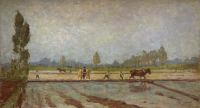
|
18.
Vecchie risaie
Olio
su masonite, 30 × 55
cm
Firmato
in basso a destra, non datato
Collezione
privata
Sino
agli anni Sessanta, nel territorio cuggionese era diffusa la
coltivazione del riso, insieme all’allevamento dei bachi da
seta.
Dallo stile e dalla tematica
della fatica dell’uomo a confronto con la natura, Vecchie risaie sembrerebbe risalire al periodo intorno al 1920
(vedi, a confronto, il dipinto n. 28, anch’esso ispirato al
lavoro dei campi). Vi è, inoltre, presso la famiglia, un bozzetto
del tutto simile (olio su cartone pressato, 15 × 22 cm).
|
18.
Old
rice paddies
Oil
on masonite, 30 X55 cm.
Signed
on the lower right side, undated
Private
collection
Till
the Sixties the cultivation of rice and sericulture were common in
the territory of Cuggiono. According to the style and the themes
of human labour confronted with nature, Old
rice paddies might be traced back to the 1920s (see also
painting n. 28 inspired by field labour).
His
family also holds a similar sketch (oil on pressed cardboard, 15 X
22 cm.).
|
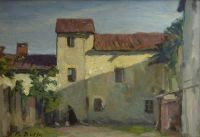
|
19.
Cortile di via Bossi,
Cuggiono
Olio
su tavola, 30 × 40
cm
Firmato
in basso a sinistra, non datato
Collezione
privata
Qui
particolarmente netto il taglio luce/ombra che caratterizza molti
scorci urbani, dove le ombre disegnate allagano il primo piano
delle strade, corrono lungo i muri, precipitano dai tetti (vedi
anche i nn. 4, 6, 17)
|
19.
Cuggiono : courtyard in via
Bossi
Oil
on wood, 30 X40 cm.
Signed
on the lower left side, undated
Private
collection
Notice
the clear contrast light/shadow that characterizes many urban
views where the painted shadows flood the foreground of the streets,
run along the walls, fall from the roofs. (see also paintings n.
4,6, 17).
|
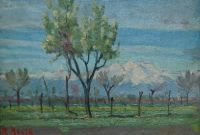
|
20.
Primavera. Cuggiono
Olio
su cartone pressato, 15,5
× 22,5 cm
Firmato
in basso a sinistra, non datato
Titolato
a retro, sul cartone, “Primavera. Cuggiono”
Collezione
privata
In
maniera quasi stilizzata, con i verdi tenui a sfumare nelle
tonalità del rosa e dell’azzurro, l’eterna poesia della
natura che ridà foglie e fiori ai tronchi spogli. Con una tale
forza che l’albero in primo piano domina i tre livelli
dell’orizzonte a salire: il prato, la montagna, il cielo. A
dimostrare come anche nella piccola dimensione si possa comporre
con largo respiro.
|
20.
Cuggiono.
Springtime
Oil
on pressed cardboard, 15.5 X 22.5 cm.
Signed
on the lower left side, undated.
Titled
on the back, on the cardboard, “Springtime in Cuggiono”
Private
Collection
The
eternal poetry of nature readorning the bare trunks with leaves
and flowers painted in a nearly stylized manner with pale greens
shading into pink and azure. A great strength with the tree in the
foreground dominating the three ascending levels of the horizon --
the meadow, the mountain, the sky -- to demonstrate that it’s
possible to compose at a wide range also in the small dimension.
|
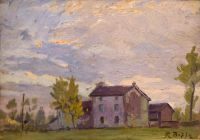
|
21.
“Cascina Americana”, in
fondo a via Villoresi
Olio
su tavola, 15 × 22
cm
Firmato
in basso a destra, non datato
Titolato
a retro, sulla tavola “Cuggiono”
Collezione
privata
Una
delle molte case e cascine, simili fra loro, che seminano la
campagna intorno a Cuggiono. Deve il suo ‘soprannome’ al fatto
di essere stata costruita, come diverse altre nella zona, grazie
alle rimesse degli emigranti.
“Partivamo
in bicicletta ben carichi sia nelle belle giornate di primavera e
d’estate che in autunno. D’inverno ci limitavamo ai dintorni
di Cuggiono… lui dipingeva ed io disegnavo felice al suo fianco
” ricorda, nella sua testimonianza, la
figlia di Borsa, Giuliana.
|
21.
“American
farmhouse”, at the end of via Villoresi
Oil
on wood, 15 X22 cm.
Signed
on the lower right side, undated
Titled
on the back of the wood “Cuggiono”
Private
collection
One
of the many houses and farmhouses, all alike, that dot the
countryside around Cuggiono. Its nickname denotes that it was built
thanks to the remittances of the migrants.
Giuliana
Borsa remembers her father : “We left by bicycle, well loaded,
both during the beautiful Spring and Summer days and the Fall. In
the Winter we just stayed around Cuggiono …he painted and I
happily drew at his side”.
|
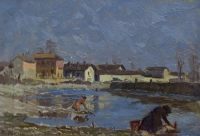
|
22.
“Al Bugnét da Bernà”.
Asciutta del Naviglio, Bernate Ticino
Olio
su cartone pressato, 15
× 22 cm
Firmato
in basso a sinistra, non datato
Collezione
privata
Due
volte all’anno, a marzo e a settembre, il Naviglio viene
‘asciugato’ per la pulizia e, in un’atmosfera di tocco
espressionista, le lavandaie usano delle poca acqua rimasta,
mentre l’architettura di Bernate, che chiude l’orizzonte, è
resa in una sintesi di forme come moduli.
Per
l’esattezza, si tratta del rione Bugnét,
gruppo di case rurali situato sulla sinistra del Naviglio, a valle
del ponte che collega i due nuclei del paese (vedi anche il n. 29).
Sulla riva opposta corre l’alzaia, percorsa da carri agricoli e
da cavalli (poi trattori) al traino dei barconi che facevano la
spola tra le cave di sabbia di Castelletto di Cuggiono e la
darsena milanese di Porta Ticinese.
Di
medesimo soggetto – se pure con inquadratura aperta sulla destra
e tavolozza più calda e solare – esiste un dipinto di maggior
dimensione (olio su tavola, 50
× 70 cm, firmato
in basso a destra, non datato; collezione privata), passato
all’asta con cui, nel settembre 2004,
si misero all’incanto i beni e gli arredi della Società Artisti
e Patriottica, la storica istituzione milanese di piazza
Belgiojoso. Nell’occasione della vendita, il paesaggio –
erroneamente titolato in catalogo come Il
Lambro – fu riconosciuto dall’attuale proprietario,
originario di Bernate, del quale, fra le documentazioni della
mostra, si propone una puntuale e commossa testimonianza, da cui
anche il titolo Al Bugnét
da Bernà e una datazione agli anni Quaranta.
Le
lavandaie in ginocchio sull’assìn,
presenti nell’opera qui esposta (verosimilmente studio ripreso
dal vero per il quadro della Patriottica), sono altro motivo
tipico di eredità verista, ancora una volta riferito al tema
sociale della fatica umana (vedi il n. 33).
|
22.
At the “Bugnèt da Bernà”. Drainage of the Naviglio
at Bernate Ticino.
Oil
on pressed cardboard, 15 X 22 cm.
Signed
on the lower left side, undated.
Private
Collection
Twice
a year, in March and September, the Naviglio is drained for
cleaning. In an expressionist atmosphere, the laundrywomen used
the scarce water left, while the architecture of Bernate that
closes the horizon is rendered in a synthesis of forms as modules.
It’s
the locality of Bugnèt, a cluster of rural dwellings situated
on the left side of the Naviglio, downstream the bridge that
connects the two centers of the village (see also painting n. 29).
On the opposite side, the embankment traveled by carts and horses (then tractors) pulling the barges that made the
shuttle between the sandpits of Castelletto di Cuggiono and the
Milanese basin of Porta Ticinese.
On
the same subject – with a right framing and a warmer and solar
palette – there is a painting of greater dimensions (oil on wood,
50 X70 cm.) signed on the lower right side, undated, private
collection) put on auction in September 2004 together with the
properties and the furnishings of the Società Artisti e
Patriottica, the historical Milanese institution of piazza
Belgioioso.
During
the sale the landscape – erroneously titled Il
Lambro – was recognized by the present owner, a native of
Bernate to whom the title Al Bugnet da Bernà is attributed with
the dating around the 1940s.
The
laundrywomen kneeling on the washboard, present in this work (presumably
a study from life for the painting of the Patriottica) are another
typical motif of the verist heritage still referring to the
social theme of human labour ( see painting n. 33).
|
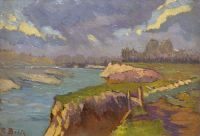
|
23.
Sponde del Ticino,
Castelletto di Cuggiono 1918
Olio
su cartone pressato, 15
× 24,5 cm
Firmato
in basso a sinistra; titolato e datato a retro, sul cartone
Collezione
privata
La tavolozza accesa e i
volumi sembrano quasi rimandare a un soggiorno parigino di Borsa,
per alcuni mesi, nel 1910-1911 (come si desume dalla datazione di
opere che hanno vedute di Parigi per soggetto), in cui l’artista
deve aver visto Cézanne e forse anche i Nabis, letteralmente le
“belve” per la violenza espressiva del colore, steso in
tonalità pure.
|
23.
Castelletto di Cuggiono :
banks of the Ticino, 1918
Oil
on pressed cardboard, 15 X24.5 cm.
Signed
on the lower left side and dated on the back, on the cardboard.
Private
collection
The
blazing palette and the volumes seem to recall a sojourn in Paris
where Borsa spent a few months in 1910-11 ( according to the
dating of the works
with sights of Paris) and probably met Cèzanne and maybe also the
Nabis, literally “the beasts” for the expressive violence of
the color spread in pure tones.
|
|
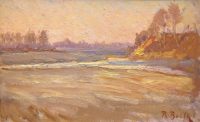
|
24.
Ticino, Castelletto di
Cuggiono 1918
Olio
su cartone pressato, 15
× 24,5 cm
Firmato
in basso a destra; titolato e datato a retro, sul cartone
Collezione
privata
Quasi
un pendant del
precedente.
|
24
Castelletto
di Cuggiono, The Ticino river ,1918
Oil
on pressed cardboard, 15 X 24.5 cm.
Signed
on the lower right side, titled and dated on the back, on the
cardboard.
Private
collection.
It
almost matches the previous one.
|
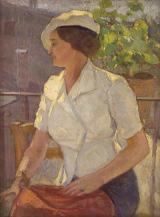
|
25.
Ritratto di Maria Clerico,
moglie dell’artista
Olio
su tela, 81 × 60,5
cm
Non
firmato né datato
Milano,
Collezione Borsa
Maria
Clerico, nata nel 1897
da famiglia cuggionese, sposa l’artista nel settembre 1918.
La storia segue un destino quasi letterario. La sorella di Borsa,
Anna, sposa il figlio medico del farmacista Bai di Cuggiono. Per
amicizia, si chiede al pittore di dare lezioni di acquerello a una
signorina del luogo, Maria. Non passa molto tempo e il maestro
chiede in moglie la giovane allieva. Comincia così anche il
rapporto affettivo e artistico di Borsa con Cuggiono, che,
compresa la tragica parentesi dello sfollamento da Milano
bombardata (1943-1946), durerà
sino al 1961… E
oltre. Perché, a Cuggiono, Borsa è sepolto.
Dall’aspetto
della signora Borsa, il ritratto è databile intorno al 1936-37
|
25.
Portrait
of Maria Clerico, wife of the artist
Oil
on canvas, 81 X 60.5cm.
Unsigned,
undated
Milan,
Borsa Collection
Maria
Clerico, was born in 1897 of a Cuggionese family, married the
artist in September 1918. The story follows an almost literary
destiny. Anna, Borsa’s sister marries a medical doctor, son of
the pharmacist Bai of Cuggiono. For friendship the painter is
asked to give acquerel lessons to a local young girl, Maria. After
a while the painter asks the young pupil to marry him. Thus begins
Borsa’s affective and artistic relationship with Cuggiono,
including the tragic period of his evacuation from Milan during
the bombings (1943-1946), that
will last until 1961 and beyond since Borsa is buried in Cuggiono.
The
look of Mrs Borsa makes the portrait datable to 1936-37.
|
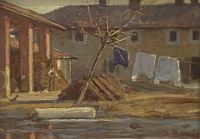
|
26.
Cascina Gambarotta, in
fondo a via San Rocco, Cuggiono
Olio
su tavola, 18,5 × 26
cm
Firmato
in basso a destra, non datato
Collezione
privata
Corte
interna e fienile, chiusi all’orizzonte, della Cascina
Gambarotta (vedi dipinto seguente). È un altro spaccato di vita
che sa di lavoro quotidiano, con la neve che si scioglie e, ancora
una volta, i panni al sole, con la loro luminosa nota di bianco.
|
26.
Cuggiono
: Farmhouse Gambarotta at the end of via San Rocco
Oil
on wood, 18.5 X 26 cm.
Signed
on the lower right side, undated
Private
collection
Internal
courtyard and hay-barn, closed at the horizon, of Gambarotta
Farmhouse ( see the following painting).
It’s another cross-section of life with its daily labour,
the melting snow and again the clothes drying in the sun with their bright
white note.
|
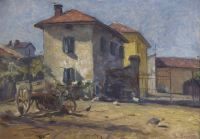
|
27.
Cascina Gambarotta e
Osteria della Madonna, Cuggiono
Olio
su tavola, 40 × 50
cm
Firmato
in basso a destra, non datato
Collezione
privata
Questa
ulteriore veduta urbana è connotata, rispetto alle altre, da un
maggior descrittivismo e precisione dei particolari.
Della
Cascina oggi restano soltanto il cancello in ferro e il fienile
(quello dell’opera precedente).
|
27.
Cuggiono
: Gambarotta Farrmhouse and the Inn of the Madonna
Oil
on wood, 40 X50 cm
Signed
on the lower right side, undated
Private
collection
This
other urban view is connoted , compared with the others, by more
descriptivism and accuracy of the details.
The
iron gate and the hay-barn (of the previous work) are the only
surviving parts of the Cascina.
|
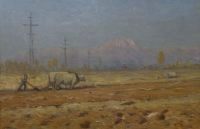
|
28.
Cirenaica, 1920
Olio
su tavola, 51 × 77
cm
Firmato
in basso a destra.
Titolato
e datato a retro, sulla tavola, “Roberto Borsa/ Cirenaica 1920”
Collezione
privata
Sul
retro della tavola, oltre al titolo e alla data, compare la
scritta “Artisti Lombardi/ I Premio Gallarate 1952”.
Fu dunque con Cirenaica
che Roberto Borsa vinse il prestigioso premio per la pittura,
allora molto ambito.
E
non è poco se si pensa che nel 1952
era già successo e stava succedendo molto: le avanguardie
storiche, il rappel à l’ordre
del periodo fascista, l’informale, l’astrattismo… Per di più,
si tratta di un’opera realizzata trent’anni prima.
Nell’Archivio Borsa sono conservati la copia del Verbale di
assegnazione da parte della giuria e un disegno sullo stesso
soggetto, qui esposto.
Si
è detto della tematica del lavoro, che in questo dipinto assume
una dimensione pressoché epica, enfatizzata dal percorso in
salita che accentua il lento avanzare degli aratori. A contrasto
con la visione ‘arcaica’, si stagliano, come croci, i piloni
della corrente elettrica, sinonimo quasi minaccioso di progresso.
Per
la cronaca, Cirenaica era, ed è, una tenuta agricola alle porte
di Cuggiono.
|
28.
Cirenaica,
1920
Oil
on wood, 51 X 77 cm.
Signed
on the lower right side.
Titled
and dated on the back, on the wood, “Roberto Borsa/Cirenaica
1920”.
Private
collection
On
the back of the wood beside the title and the date,appears the
caption “Artisti Lombardi/I Premio Gallarate 1952”. Roberto
Borsa won the prestigious prize for painting with Cirenaica,
then well coveted.
This
is quite important since in 1952 many things had already happened
and a lot more were happening : the historical avant-gardes, the
call to order of the fascist period, the informal and abstract
art..Furthermore this work was painted thirty years earlier. The
Borsa Archives contain the copy of the minutes of the jury that
assigned the prize and a drawing on the same subject, displayed in
this exhibit.
The
themes of labour of this painting acquire an epic dimension
emphasized by the slope that accentuates the slow movement of the
ploughmen. To contrast
the “archaic” vision, the electricity pylons stand out like crosses, almost like a menacing synonym of progress.
Cirenaica
was and still is a farm on the outskirts of Cuggiono.
|
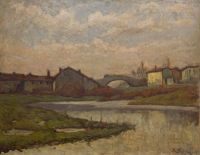
|
29.
Ponte a Bernate, 1942
ca
Olio
su tavola, 69 × 89
cm
Firmato
in basso a destra, non datato
Collezione
privata
La
datazione è desunta dallo studio – anch’esso qui esposto,
nella vetrina – titolato e datato sul retro.
In
primo piano il cosiddetto lancòn,
l’ampia risorgiva che alimenta una limpida roggia a lato del
Naviglio. Sul fondo, il ponte, sotto cui il Naviglio scorre e che
dà il titolo all’opera (vedi anche il n. 22).
|
29.
Bernate,
the bridge, circa 1942.
Oil
on wood, 69 X 89 cm.
Signed
on the lower right side, undated
Private
collection
The
dating is gathered by the study – also displayed in the showcase
– titled and dated on the back. On the foreground the so-called lancòn,
the wide resurgence that feeds a clear irrigation ditch next
to the Naviglio. The bridge In the background , under which the
Naviglio flows, gives title to the work (see also painting n. 22).
|
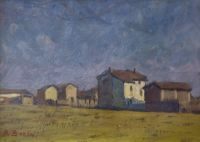
|
30.
Cascina De Carli, in fondo
a via Villoresi, Cuggiono 1944
Olio
su tavola, 15 × 21
cm
Firmato
in basso a sinistra
Titolato
e datato a retro, sulla tavola, “R. Borsa/ Cuggiono 1944”
Collezione
privata
Nella
testimonianza resa in occasione della mostra, la figlia
dell’artista, Giuliana, racconta: “Durante gli anni di guerra
mi rammento ancora le spedizioni per andare a dipingere con papà:
io con una piccola ma preziosa cassetta di colori e con l’album
di disegno e papà con una grande tela, la sua cassetta a tracolla
e il seggiolino pieghevole”. Da altri ricordi risulta che Borsa
avesse anche un contenitore dimensionato per i bozzetti, quasi
sempre, infatti – su tavoletta o cartone pressato – di 15
× 22 cm circa. Il tutto dimostra l’attitudine di Borsa
al plein air. E così devono essere nate questa e altre immagini della
terra di Lombardia, che, ridenti e malinconiche insieme, diventano
paesaggio dell’anima.
|
30.
Cuggiono : De Carli Farmhouse at the end of via Villoresi, 1944
Oil
on wood, 15 X 21 cm.
Signed
on the lowers left side
Titled
and dated on the back, on the wood, “R. Borsa/Cuggiono 1944”
Private
collection
In
the testimony given on occasion of the exhibit, his daughter
Giuliana tells : “During the years of the war I remember the
expeditions to go and paint with daddy : I carried a small but
precious colour-box and the drawing album and daddy a large canvas,
his box slung on his shoulder and his folding chair”. Other
recollections state that Borsa had a dimensioned container for his
sketches that all measured around 15 X 22 cm., on wood or pressed
cardboard. This speaks for Borsa’s attitude towards the open
air. This is how this and other images of Lombardy were born :
charming and melancholic, together a landscape of the soul.
|
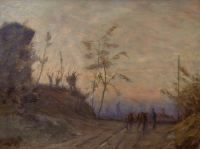
|
31.
Strada da Scansceu a
Castelletto di Cuggiono, 1943
Olio
su tavola, 30 × 40
cm
Firmato
in basso a sinistra; datato a retro, sulla tavola
Collezione
privata
Per la forte pendenza, al vecchio
tracciato, oggi praticamente dismesso, si è affiancata la nuova
strada che scende al ponte di Castelletto, sempre partendo da “Scanceu”,
o meglio, da quanto rimane di questo angolo particolarmente amato
da Borsa (vedi dipinto seguente).
|
31.
Road
from Scansceu to Castelletto di Cuggiono with the Catenazzone on
the left side.
Oil
on wood, 30 X40 cm
Signed
on the lower left side, dated on the back, on the wood.
Private
collection
Due
to the steep slope, the old route, now abandoned has been replaced
by a new road that descends to the bridge of Castelletto, always
leaving “Scansceu” or better from what is left of this corner
so much cherished by
Borsa (see the following painting).
|
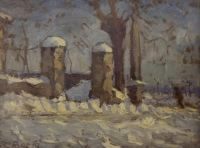
|
32.
Scansceu con la neve, 1920
Olio
su tavola, 30 × 40
cm
Firmato
in basso a sinistra, datato a retro, sulla tavola
Collezione
privata
Sul medesimo soggetto si espongono anche un bozzetto e un
disegno.
Siamo nei primi anni
dell’incontro di Borsa con Cuggiono.
L’Osteria Scansceu, posto di
ristoro e vendita di prodotti alimentari sul percorso da Cuggiono
a Castelletto (vedi l’opera precedente), è soggetto più volte
ripreso nell’alternarsi delle stagioni, raffreddato
dall’inverno o soleggiato a tinte calde (come nel
bozzetto).
L’inquadratura è sempre la
stessa – i pilastri d’ingresso, l’albero, la colonna votiva
–, giocata sulla ripresa più o meno ravvicinata del primo
piano. Ma una nota a sé merita la “figurina”, che da statico
indice di proporzione del rapporto fra uomo e natura, come appare
nel bozzetto e nel disegno, qui si anima e diviene protagonista
attiva nel suo arrancare, dentro la neve, lungo la strada per
Cuggiono. Pur nel paesaggio che sa di fiaba, va forse annotato,
quale traccia di quell’eredità verista già citata, che nella
neve la figura si trasforma da femminile con veste lunga a
maschile, quasi che i pantaloni permettano di meglio evidenziare
il movimento della faticosa avanzata.
Inoltre, pressoché identica
nell’impostazione, si è rintracciata anche una versione di
maggiori dimensioni (olio su tela, 50 × 100 cm; collezione
privata), nella quale l’indistinta “figurina”, ingrandita,
si identifica chiaramente come cacciatore, con tanto di fucile a
tracolla e cane al seguito.
|
32.
Scansceu under the snow, 1920
Oil
on wood, 30 X40 cm
Signed
on the lower left side, dated on the back, on the wood
Private
collection
On
the same subject the exhibit features a sketch and a drawing.
We
are at the beginning of Borsa’s sojourns in Cuggiono.
The
Scansceu Inn, a sort of a restaurant and food store on the route
Cuggiono – Castelletto (see
the previous painting) is a theme portrayed more times during the
changes of the seasons, cooled by the Winter or sun-baked in warm
tones (as in the sketch)
The
framing is always the same – the gate-posts, the tree, the
votive column – played on a more or less closer range of the
foreground. A special mention is deserved to the “figurine”,
that from a static index of proportion of the relationship
man-woman, as it appears in the sketch and drawing, here comes to
life and becoming an active protagonist in his trudging in the
snow on the way to Cuggiono. Although the landscape reminds of a
fairy tale it must be remarked, as a
trace of the verist heritage already mentioned, that the
figure in the snow turns from feminine with a long dress into a
male one, as if the
pants
can better underline the fatiguing forward movement.
In
addition, another version of bigger dimensions has been found (oil
on canvas, 50 X 100 cm.), private collection) where the indistinct
“figurine”, once enlarged, is clearly identified as a hunter
with his gun slung on his shoulder and his dog after him.
|
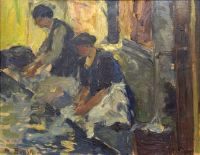
|
33.
Lavandaie
Olio
su tavola, 35 × 45
cm
Firmato
in basso a sinistra, non datato
Titolato
a retro, sulla tavola
Collezione
privata
Opera
sicuramente anomala nel percorso sin qui seguito, perché, pur non
essendo un ritratto, è impostata sulla figura in primo piano, in
un interno (il lavatoio), senza orizzonte e senza paesaggio.
Sembrerebbe uno studio per un dipinto più articolato. Le tonalità
sulla gamma dei bruni intensi rimandano a una datazione precoce.
|
33.
Laundrywomen
Oil
on wood, 35 X 45 cm
Signed
on the lower left side, undated
Titled
on the back, on the wood
Private
collection
This
is an anomalous work considering the path followed by the artist
so far. It’s not a portrait but it’s centered on the figure in
the foreground, in the interior of a wash-house, with no horizon
nor landscape. It seems the study for a more articulated painting.
The shades on the spectrum of rich browns suggest a very early
dating.
|
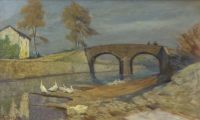
|
34.
Il ponte di Castelletto di
Cuggiono
Olio
su tavola, 54 × 90
cm
Firmato
in basso a sinistra, non datato
Dono
del tenore Gino Ballarati alla Parrocchia dei Santi Giacomo e
Filippo di Castelletto. Milano, 13
maggio 1990.
Tuttora
di proprietà della Parrocchia.
Si
veda anche la scheda n. 2.
|
34.
Castelletto
di Cuggiono, the bridge
Oil
on wood, 54 X90 cm.
Signed
on the lower left side, undated
A
gift of tenor Gino Ballarati
to Sts. James and Philip Parish in Castelletto. Milan, 13 May
1990.
Still
property of the Parish.
See
card n.2
|
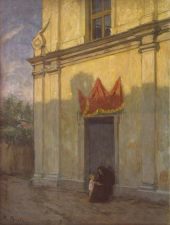
|
35.
La Chiesa di Santa Maria in
Braida, Cuggiono
Olio
su tela, 80 × 60
cm
Firmato
in basso a sinistra, non datato
Collezione
privata
Il
sostantivo “braida” o “brera”, di derivazione longobarda,
significa piano, pianura, campo, prato nei pressi di un centro
abitato.
Costruita
in due mesi, dal 5
aprile al 13
giugno 1777, la
Chiesa di Santa Maria in Braida andò a sostituire un antico
oratorio, risalente al XIII
secolo, che la famiglia Carisi, proprietaria del terreno su cui
sorgeva, in buona fede ma abusivamente (si direbbe oggi) perché
pubblica, incorporò nell’attigua casa colonica. Per rimediare
all’errore, i Carisi edificarono una nuova Chiesa, anch’essa
pubblica (pur appartenendo a privati), tant’è che si apre sulla
strada.
Il
vecchio oratorio fu abbattuto nel 1997,
insieme alla casa colonica. Il nuovo passò agli Oltrona Visconti,
eredi dei Carisi, e poi ai Mapelli.
Venduta
con l’intera proprietà a una società immobiliare, la Chiesa fu
fortunatamente lasciata intatta nella ristrutturazione. Ora è
sede dell’Ecoistituto della Valle del Ticino, che si è assunto
il compito del restauro, recentemente ultimato, ed è destinata ad
attività culturali ed espositive, come questa odierna mostra in
omaggio a Roberto Borsa.
Il
quale, per altro, nei soggiorni cuggionesi, le abitava
praticamente di fronte, occupando la famiglia della moglie un
appartamento e dei locali adibiti a negozio nello stabile
appartenente ai Clerici.
|
35.
Cuggiono, The church of Santa Maria in
Braida
Oil
on canvas, 80 X60 cm.
Signed
on the lower left side, undated
Private
collection
The
Longobard term “braida” or “brera” means plain, prairie,
field, meadow near a built-up area.
The
church of Santa Maria in Braida
was built in two months from April 5th to June
13th 1777 to replace an old oratory that dated back to the 13th
century that the Carisi family, owner of the land incorporated in
good faith, but illegally, into the adjacent farmhouse. The
Carisis rectified the mistake by erecting a new church still
public, in spite of being a private property, that opens onto the
street.
The
old oratory was demolished in 1997 with the farmhouse. The new one
was inherited by the Oltrona Viscontis
and then by the Mapellis.
The
church which had been sold to a real estate company with the
entire property was left untouched during the restructuring.
Now
it houses the Ecoistituto della Valle del Ticino that has
undertaken the task of restoring it
and now that the job has been completed, it will be devoted to
cultural activities and exhibits like this one honoring Roberto
Borsa, who incidentally during his sojourns in Cuggiono faced it,
because his wife’s family occupied an apartment and premises in
the building owned by the Clericis.
.
|
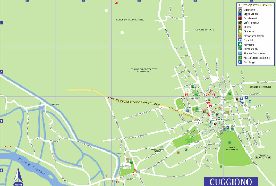 |
Su
questa piantina di Cuggiono sono evidenziati con numeri rossi i
luoghi rappresentati nei quadri. Cliccare sul numero per vedere il
relativo quadro
Scarica
il file pdf (1,4MB) |
Map
shows for each paint the geographically location in Cuggiono.
Click
on the number in order to seet the paint.
Download
(1,4MB)
|
|
|
|